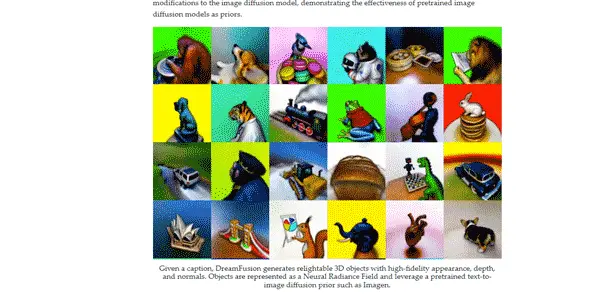DreamFusion 3D

From the generation of 3D objects from a textual prompt
DreamFusion 3D: Generating 3D Models from Text Prompts
DreamFusion 3D is a groundbreaking AI tool capable of generating three-dimensional (3D) models directly from text descriptions. This innovative technology leverages the power of large language models and diffusion processes to translate natural language prompts into realistic and detailed 3D objects, marking a significant advancement in AI-driven 3D content creation. Categorized as both a 3D model generator and a noteworthy GitHub project (making its code publicly accessible), DreamFusion 3D offers a unique and powerful approach to digital modeling.
What DreamFusion 3D Does
DreamFusion 3D bridges the gap between textual descriptions and 3D models. Instead of requiring complex 3D modeling software and expertise, users can simply input a text prompt describing their desired object, and the AI will generate a corresponding 3D model. This is achieved through a sophisticated process combining a text-to-image diffusion model with a neural radiance field (NeRF) rendering technique. The text prompt informs the diffusion model, which then generates a sequence of 2D images representing the object from various viewpoints. These images are then used to train a NeRF, creating a 3D representation that can be rendered from any angle.
Main Features and Benefits
- Text-to-3D Generation: The core feature is its ability to generate high-quality 3D models directly from natural language input. This significantly lowers the barrier to entry for 3D modeling.
- High Fidelity Output: DreamFusion 3D produces detailed and realistic 3D models, even with complex descriptions.
- Ease of Use: The process is relatively straightforward, requiring only a text prompt, making it accessible to a wider range of users, including those without extensive 3D modeling experience.
- Open-Source Availability: Being a GitHub project allows for community contributions, improvements, and further development.
- Versatility: The tool can handle a wide range of descriptions, enabling the creation of diverse 3D models across various categories.
Use Cases and Applications
DreamFusion 3D opens doors to numerous applications across various industries:
- Game Development: Quickly prototype game assets and environments.
- Film and Animation: Generate preliminary 3D models for characters, props, and sets.
- Architectural Visualization: Create 3D models of buildings and spaces from textual descriptions.
- Product Design: Rapidly prototype new product designs based on textual specifications.
- Education: Provide an accessible and intuitive tool for teaching 3D modeling concepts.
- Virtual and Augmented Reality: Generate 3D assets for immersive experiences.
Comparison to Similar Tools
DreamFusion 3D stands out from other 3D modeling tools due to its direct text-to-3D generation capability. While other tools may offer text-based input for parameters or styles, DreamFusion 3D directly interprets the descriptive text to create a 3D object without the need for intermediate steps like sketching or manual adjustments. However, it's important to note that the quality and detail of the generated models may still vary depending on the clarity and specificity of the text prompt. Other tools might excel in specific areas like precise control over model geometry or material properties, which DreamFusion 3D currently lacks to some extent.
Pricing Information
DreamFusion 3D is currently free to use. As an open-source project, the source code is publicly available on GitHub, enabling anyone to access and utilize the technology. However, the computational resources required to run the model can be significant, potentially requiring access to powerful hardware.
Conclusion
DreamFusion 3D represents a significant leap forward in AI-powered 3D modeling. Its ability to generate high-quality 3D models directly from text prompts opens up exciting possibilities for creative professionals and hobbyists alike. Although limitations remain, its free and open-source nature fosters ongoing development and community contributions, promising further improvements and expansion of its capabilities in the future.